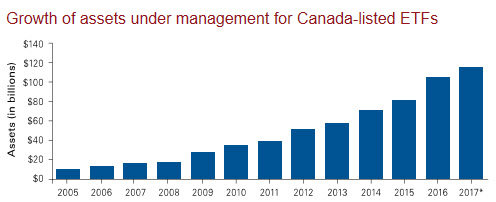
By Atul Tiwari
Special to the Financial Independence Hub
With summer in full swing, along with warmer weather and blooming gardens, it got me thinking about cycles in investing. In particular ETFs, which have been taking root in Canada over the past few years.
When Vanguard entered the Canadian market in December 2011, we were one of only eight ETF providers. Our own evolution illustrates how much has changed in just over five years: We started with six index-based ETFs and currently offer a lineup of 33 ETFs, including four actively managed equity factor-based ETFs launched in June 2016.
Industry-wide more than 500 ETFs now vie for the attention of investors and advisors. And it’s not just products that have proliferated; new ETF providers enter the industry every month. More than $130 billion in Canada-domiciled ETF assets is now divided among 24 ETF providers. And there’s room to grow. ETFs make up only 8% of Canadian investable assets while capturing 25% of industry flows for the first quarter.1
Investors have clearly grown more comfortable adding ETFs to their portfolios. While I’m not one to make predictions about whether the pace of expansion will continue, I do see three trends that tend to favour it.
1.) Greater fee transparency
Thanks to the second phase of Canada’s Client Relationship Model reforms (CRM2), investors are starting to see — in dollar terms on their account statements — what they’re paying their advisory firms. Canadian regulators are also considering a potential ban on embedded trailing commissions. This will surely generate discussion and shine an even brighter light on investment fees.
No less an expert than billionaire investor Warren Buffett extolled the long-term benefits of low-cost investing in his 2016 letter to Berkshire Hathaway shareholders. Cost plays a critical role in total investment return. The less investors pay in fees, the more of the potential returns they can keep. This is true whether you are investing in an ETF, mutual fund or any other investment vehicle.
2.) Fee-based advisors are on the rise
Driven partly by regulatory changes and heightened awareness of investment fees, many financial advisors are moving to fee-based business practices. We favour this transition as we believe it better aligns advisors with the needs of investors and creates full transparency.
We think fee-based advisors will continue to gravitate towards ETFs and other lower-cost investment vehicles to bring down the overall cost of investing for their clients.
Adopting a fee-based practice model can also help address the common misconception that financial advice is free.
3) Cash continues to flow into ETFs around the world
2016 was a record year for ETF inflows in Canada, and they remain strong in 2017. With all this growth, is Canada’s ETF market getting a little crowded? Not likely when you compare it to more mature ETF ecosystems elsewhere. In many respects, the Canadian ETF industry is still in the early part of its development.
Worldwide, ETF assets under management continue to expand, topping USD 4 trillion for the first time in April. Globally, more than 300 firms have listed nearly 7,000 exchange-traded products (ETPs). The United States had 2,011 ETPs from 112 providers as of April 30, 2017, while the more fragmented European market had 2,257 ETPs from 56 providers in 21 countries.2
Just like summer, the ETF industry has been heating up. For investors and advisors in Canada, this growth means a greater breadth of investing options to consider when building long-lasting portfolios.
1 Source: Strategic Insight, as of March 31, 2017.
2 Source: ETFGI press release dated May 17, 2017.
 Atul Tiwari is the managing director and head of Vanguard Canada. He is a former chair of the Canadian ETF Association, has held a variety of senior asset management positions in Canadian financial services organizations and has past experience practicing law, having been called to the Law Society of Upper Canada and the Supreme Court of England and Wales.
Atul Tiwari is the managing director and head of Vanguard Canada. He is a former chair of the Canadian ETF Association, has held a variety of senior asset management positions in Canadian financial services organizations and has past experience practicing law, having been called to the Law Society of Upper Canada and the Supreme Court of England and Wales.


I keep hearing how more and more money is flowing into ETF’s and how “dangerous” it is. The same thing was said about mutual funds at one point. What i am wondering is if most of the funds that used to flow into mutual funds are now flowing into ETF’s due to the reasons indicated above. Is there any data on these flows? Are larger mutual fund accounts now moving over to ETFs? Any thoughts?
The Hub recently ran a guest blog on the “great migration” from mutual funds to ETFs:
https://findependencehub.com/add-value-great-migration-mutual-funds-etfs/